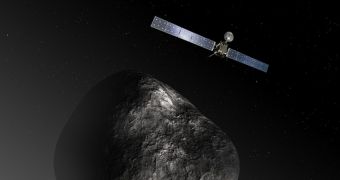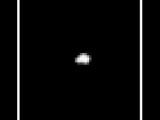Not too long ago, the European Space Agency's Rosetta, i.e. a robotic spacecraft launched back in March 2004, had the chance to snap a few images of a comet known to the scientific community as 67P/Churyumov-Gerasimenko.
If you think 67P/Churyumov-Gerasimenko is a rather nasty name (feel free to read “nasty” as “downright ugly”), wait till you hear about what the Rosetta spacecraft revealed about this comet's nucleus while stalking it.
Long story short, researchers with the European Space Agency say that, according to data provided by the aforementioned robotic spacecraft, comet 67P/Churyumov-Gerasimenko's nucleus is a bit Quasimodo-like.
Thus, the images obtained with the help of OSIRIS, which is the scientific imaging system onboard Rosetta, indicate that said celestial body's nucleus is fairly irregular and fairly elongated, Phys Org informs.
As noticeable in the series of images below this article, which were taken about four hours apart and which document the appearance of the comet from various angles, 67P/Churyumov-Gerasimenko's nucleus appears to sport three prominent structures.
Then again, it might be that the comet's nucleus owes its deformed looks to a deep depression running through it, European Space Agency scientists who have had the chance to look at these images and study them detail.
“From what we can discern in these early images, 67P is an irregularly looking body,” explains OSIRIS Principal Investigator Holger Sierks with the Max Planck Institute for Solar System Research (MPS) in Germany.
Interestingly enough, astronomers say that there is absolutely no reason for 67P/Churyumov-Gerasimenko to be embarrassed about what its nucleus looks like. This is because small bodies such as asteroids and comets are often irregular.
In fact, it looks like, out of the five cometary nuclei the spacecraft have until now been able to get close enough to photograph, all were eventually found to be not spherical, but irregular in the most unique of ways.
Thus, one other comet, which goes by the name 103P/Hartley, appears to have a surprisingly elongated body whose shape astronomers claim is strikingly similar to that of a juggling club.
Commenting on Rosetta's obtaining these images of comet 67P/Churyumov-Gerasimenko and thus helping astronomers gain a better understanding of this celestial body, scientist Jean-Baptiste Vincent says, “ Seeing 67P now slowly revealing its own unique features is an unprecedented adventure.”
In case anyone was wondering, the series of images below was obtained this past July 4. At that time, the Rosetta spacecraft was located at a distance of about 37,000 kilometers (approximately 22,990 miles) from comet 67P/Churyumov-Gerasimenko.

 14 DAY TRIAL //
14 DAY TRIAL // 

